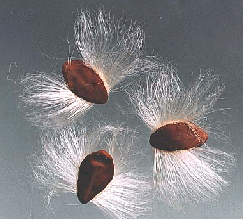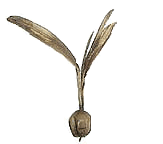seed dispersal
Over evolutionary time plants have evolved extraordinary ways of dispersing their seeds to minimize competition. Here are a few ways seeds have been specialized to disperse via different ways.
wind
There are actually several different types of wind dispersed seeds: gliders, parachutes, helicopters, and cottony seeds (Waynes World). Wind dispersed seeds need to be light for obvious reasons, but some of them are flat and have slight curves in them to helicopter away. Dandelions are an example of parachute seeds, due to their wispiness they can be easily moved via the wind.

Cottony
Image by Ms Nucleus

Helicopter
Image by Palomar

Glider
Image by Ons Zaden
Water
Water dispersed seeds are also lightweight in order to float along any rivers or oceans they might fall into. This allows for extremely far dispersal lengths. One classic example of a water dispersed seed is the coconut! Due to its hollowness this seed was able to drift from some other distant continent all the way to the volcanic Hawaiian islands. Many species of plants have a special coating on the outside that allows them to travel along water for a limited amount of time until the coat disintegrates and the seed falls to the floor of the river or lake and establishes there. Mangrove seeds are long and float vertically and grow roots before they sink and establish at the bottom of an estuary. They are the only seed that germinates while still attached to the maternal plant because they would float away and never establish in the sand.

Coconut seed
Image by National Geographic

Mangrove seed germinated on maternal plant
Image by Tropical Ospreys

Mangrove seeds floating
Image by Smithsonian Ocean
Animal
Animal dispersed seeds typically have hooks or spikes that easily attach to the fur of an animal that happens to brush against it. Foxtails and burrs are problematic when stuck in the skin and fur of your pet but this is a classic example of how animal dispersed seeds work. Animals act as seed dispersers for fruit-bearing plants as well. Plants produce sugar rich fruits that are seen as a hearty food source for animals like coyotes and bears. These fruits have seeds that cannot be digested and are dispersed through the feces of fruit eating animals.

Burrs
Image by SCNow

Bear eating berries
Image by Wise about Bears
